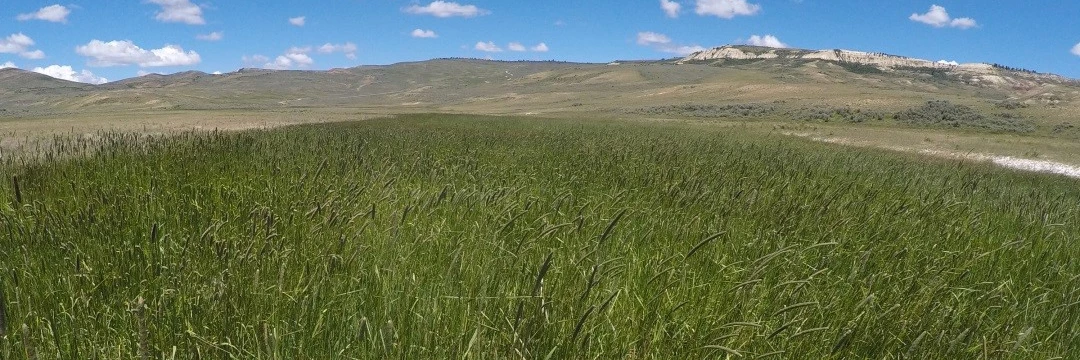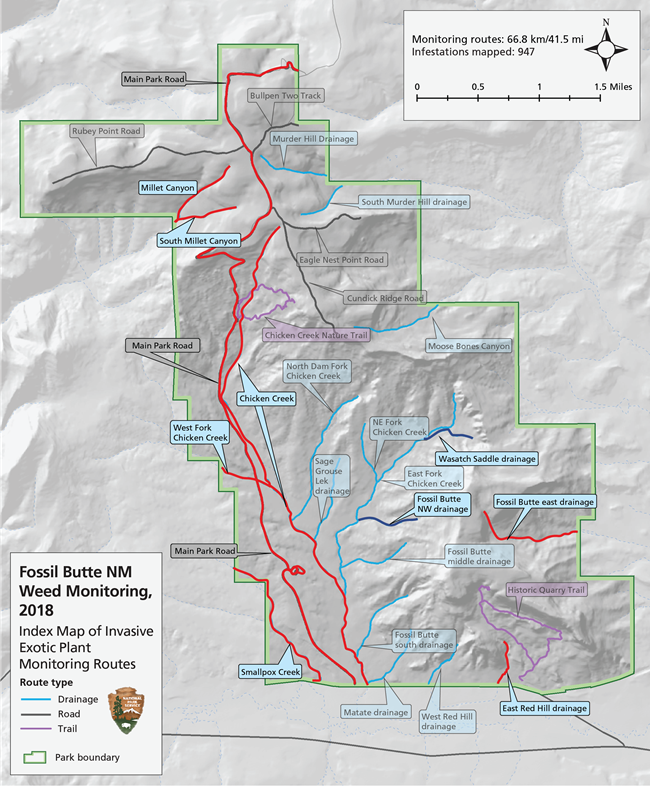Last updated: September 15, 2022
Article
Invasive Exotic Plant Monitoring at Fossil Butte National Monument, 2018

Invasive exotic plants are one of the most significant threats to natural resources in the national parks today. To provide early warning of weed invasions, the Northern Colorado Plateau Network (NCPN) monitors for these species in areas where they are likely to first establish: along roads, trails, and waterways.
What Are Invasive Exotic Plants?
Invasive exotic plants (IEPs) are species whose introduction to an environment “does or is likely to cause economic or environmental harm or harm to human health.” In national parks, IEPs can alter ecosystems at multiple scales—threatening wildlife, natural landscapes, and recreational opportunities.
IEPs are able to reproduce prolifically, rapidly colonize new areas, and displace native species. Invasive plants fill different ecological roles than the native plants they replace, leaving gaps in the system. In the absence of the native plants, the needs of species that depended on the native vegetation may go unmet, potentially creating a cascade of ecological effects.
The good news is that if discovered before they have a chance to take hold, IEP populations can be eradicated from parks. Small populations are cheaper and easier to control than large populations. Therefore, early detection is critical.
What Can Be Done?
To help park managers identify IEPs and prioritize control efforts, the Northern Colorado Plateau Network (NCPN) monitors invasive exotic plants in eight National Park Service units. First, network and park staff create a list of priority IEPs for each park. Then, on a rotating schedule, a field crew visually surveys for those IEPs along established monitoring routes. Along the routes, they stop and set up plots for additional data collection. The plot data allow network ecologists to estimate trends over time.
During data analysis, a Patch Management Index (PMI) helps identify the scale of the problem presented by each patch of exotic plants. PMI multiplies the size of each patch by the amount of each patch that is covered in weeds to arrive at a composite score. The PMI score is assigned to a class ranging from very low to very high.
To be useful, PMI must be considered in combination with species and patch numbers. In many cases, targeting patches with very low or low PMI allows managers to keep small patches from growing into bigger problems. On the other hand, a species with many patches of very low or low PMI may be harder to treat than a different species with just a few patches of high or very high PMI.

Recent Monitoring at Fossil Butte National Monument
During monitoring from June 28 to July 1, 2018, a total of 16 different IEP species were detected along 66.8 kilometers (41.5 mi) of monitoring routes and transects at Fossil Butte National Monument. Of these, 11 were priority species that accounted for 947 separate patches. Most patches were classified as “very low” in PMI, indicating that weeds in the park are widely but sparsely distributed. Controlling these populations will mean travel across broad areas.
Cheatgrass (Bromus tectorum), creeping foxtail (Alopecurus arundinaceus), and Japanese brome (Bromus japonicus) were the most widespread species at the park in 2018. Each has been increasing across all years they have been monitored. The next-most widespread species was flixweed (Descurainia sophia), which has decreased every monitoring year since 2014. Musk thistle (Carduus nutans) has also decreased since 2014. Areas away from riparian zones and the main park road tend to have fewer IEPs. In contrast, the highest densities of IEP patches were detected in several drainages (East Red Hill, South Millet Canyon, West Fork Chicken Creek, Millet Canyon, Chicken Creek, Fossil Butte East, Smallpox Creek) and along the main park road (see map).
| Scientific name | Common name |
| Agropyron cristatum | crested wheatgrass |
| Alopecurus arundinaceus* | creeping foxtail |
| Bromus japonicus* | Japanese brome |
| Bromus tectorum* | cheatgrass |
| Cardaria sp.* | whitetop |
| Carduus nutans* | musk thislte |
| Cirsium arvense* | Canada thistle |
| Convolvulus arvensis* | field bindweed |
| Descurainia sophia* | flixweed |
| Elymus repens* | quackgrass |
| Hyoscyamus niger* | black henbane |
| Lactuca serriola | prickly lettuce |
| Melilotus officinalis* | yellow sweetclover |
| Poa bulbosa | bulbous bluegrass |
| Thlapsi arvense | field pennycress |
| Tragopogon dubius | yellow salsify |
*priority species
Control efforts by park staff are likely helping to prevent some IEP increases in the park. In 2018, a total of 7,984 plants were pulled, 0.73 acres of IEPs were sprayed, and 41 thirty-three-gallon bags of mowed cheatgrass were removed from the park.
Only two monitoring routes were found to be weed-free in 2018: the Fossil Butte NW and Wasatch Saddle drainages (see map). Eliminating IEP patches in nearby drainages and trails may help keep these areas weed-free. Areas with low numbers of IEPs per kilometer (East and NE forks of Chicken Creek, Sage Grouse Lek drainage, Murder Hill drainage, Cundick Ridge and Eagle Nest Point roads) should be priority locations for future control efforts.
Network staff will return to re-sample all monitoring routes in 2020.
For more information, see A. Washuta and D. W. Perkins, Invasive Exotic Plant Monitoring in Fossil Butte National Monument: 2018 Field Season
